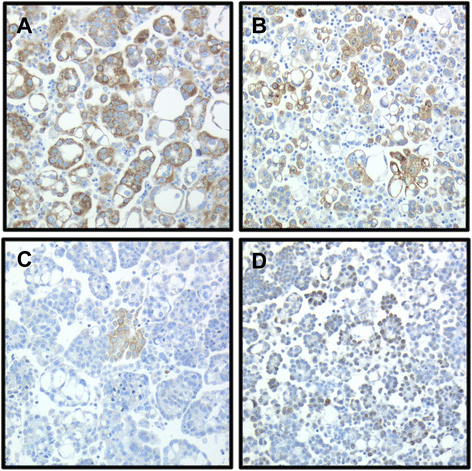CIAPIN1 and ABCA13 are markers of poor survival in metastatic ovarian serous carcinoma
- PMID: 25889687
- PMCID: PMC4336750
- DOI: 10.1186/s12943-015-0317-1
CIAPIN1 and ABCA13 are markers of poor survival in metastatic ovarian serous carcinoma
Abstract
Background: The objective of this study was to investigate the expression and clinical role of 14 genes previously shown to be associated with chemotherapy response and/or progression-free survival in a smaller series of ovarian serous carcinoma effusions.
Methods: Advanced-stage serous ovarian carcinoma effusions (n = 150) were analyzed for mRNA expression of AKR1C1, ABCA4, ABCA13, ABCB10, BIRC6, CASP9, CIAPIN1, FAS, MGMT, MUTYH, POLH, SRC, TBRKB and XPA using quantitative real-time PCR. mRNA expression was studied for association with clinicopathologic parameters, including chemotherapy response and survival.
Results: ABCA4 mRNA expression was significantly related to better (complete) chemotherapy response at diagnosis in the entire cohort (p = 0.018), whereas higher POLH mRNA levels were significantly related to better chemoresponse at diagnosis in analysis to 58 patients with pre-chemotherapy effusions treated with standard chemotherapy (carboplatin + paclitaxel; p = 0.023). In univariate survival analysis for patients with pre-chemotherapy effusions (n = 77), CIAPIN1 mRNA expression was significantly related to shorter overall (p = 0.007) and progression-free (p = 0.038) survival, whereas ABCA13 mRNA expression was significantly related to shorter OS (p = 0.024). Higher CIAPIN1 mRNA expression was an independent marker of poor overall survival in Cox multivariate analysis (p = 0.044).
Conclusions: Our data identify ABCA4 and POLH as markers of better chemotherapy response in metastatic serous carcinoma. CIAPIN1 and ABCA13 may be novel markers of poor outcome in pre-chemotherapy serous carcinoma effusions.
Figures


References
-
- Cancer Registry of Norway . Cancer in Norway 2010 - Cancer incidence, mortality, survival and prevalence in Norway. Oslo: Cancer Registry of Norway; 2012.
-
- Davidson B. Ovarian and Primary Peritoneal Carcinoma. In: Davidson B, Firat P, Michael CM, editors. Serous Effusions- Etiology, Diagnosis, Prognosis and Therapy. London: Springer; 2011. pp. 167–204.
Publication types
MeSH terms
Substances
LinkOut - more resources
Full Text Sources
Other Literature Sources
Medical
Molecular Biology Databases
Research Materials
Miscellaneous

